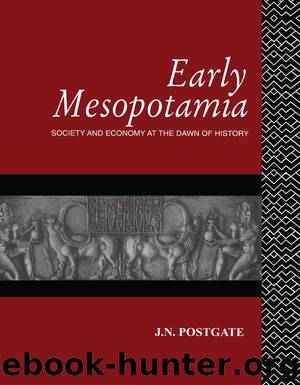Early Mesopotamia by Postgate Nicholas

Author:Postgate, Nicholas [Postgate, Nicholas]
Language: eng
Format: azw3
ISBN: 9781138170766
Publisher: Taylor and Francis
Published: 2017-07-04T16:00:00+00:00
The merchants will also have profited, but their role is best illustrated by moving back in time about a century, and downstream to Larsa, shortly after its incorporation into the kingdom of Hammurapi. Texts, presumably from the palace archives, which must have been illicitly excavated at the site itself, continue to surface in museums, giving us increasingly fine detail of the organization, but already the broad outlines are clear. In Text 10:9, Ili-iqišam has a concession from the palace for a certain quantity of merchandise, and this has passed, in some way not made explicit, to four persons who now sell it to Ibni-Amurru. He pays them one-third of the face value of the goods, and receives the goods: that is to say, he physically receives the fish, dates and garlic, but the wool will not become available to him until the shearing, which takes place around the Babylonian New Year, in seven months’ time. In return, he is to pay the sum owed to the palace at the end of the fifth month, i.e. in eleven months’ time.331
Two features of this transaction favourable to the merchant are immediately apparent: he pays only two-thirds of the nominal value of the goods, and for one of those thirds there is a long delayed repayment date. As for the repayment date, this is only one possible arrangement; sometimes the contract specifies ‘at the payment of the “allocation”’ (ina šaqāl sūtim), in other cases it may simply say ‘when the palace requests it’, or ‘when the messenger (našpar) comes from the palace’. Amounts sometimes remained unpaid for more than one year: one contract from Samsu-iluna Year 3 Month VI, deals with amounts of dates from the first and second years of his reign.332
As for the difference between the sum actually paid by the merchant and the face value of the goods, in the Larsa texts the separate payments are regularly exactly one-third, and the transactions are sometimes quite explicitly described as ‘at a third’. The later Sippar texts do not give the same detail, but no doubt a similar arrangement was in force. Quite how advantageous this apparent 50 per cent profit was for the merchants is another question, which cannot be answered at present: for one thing they had the expenses of transport, storage and distribution to meet, and in the later texts at least it is clear that these were considerable, since the merchants were expected to come from Sippar to Babylon to take delivery of the merchandise (Text 10:10).333 Then of course we are not told the exact significance of the starting price, which I have called the ‘nominal value’, and which may have been known as the ‘palace price’ (kār ēkallim).334 Our texts do not usually specify the amounts of each commodity, merely the silver value, no doubt because they were tied to a known equivalent. Precisely for this reason, they seem unlikely to be prices current in the market situation where the merchants would be making their sales
Download
This site does not store any files on its server. We only index and link to content provided by other sites. Please contact the content providers to delete copyright contents if any and email us, we'll remove relevant links or contents immediately.
The Daily Stoic by Holiday Ryan & Hanselman Stephen(2708)
The Fate of Rome: Climate, Disease, and the End of an Empire (The Princeton History of the Ancient World) by Kyle Harper(2436)
People of the Earth: An Introduction to World Prehistory by Dr. Brian Fagan & Nadia Durrani(2346)
Ancient Worlds by Michael Scott(2102)
Babylon's Ark by Lawrence Anthony(2070)
Foreign Devils on the Silk Road: The Search for the Lost Treasures of Central Asia by Peter Hopkirk(2056)
India's Ancient Past by R.S. Sharma(1987)
MOSES THE EGYPTIAN by Jan Assmann(1972)
The Complete Dead Sea Scrolls in English (7th Edition) (Penguin Classics) by Geza Vermes(1840)
Lost Technologies of Ancient Egypt by Christopher Dunn(1797)
The Daily Stoic by Ryan Holiday & Stephen Hanselman(1768)
The Earth Chronicles Handbook by Zecharia Sitchin(1744)
24 Hours in Ancient Rome by Philip Matyszak(1676)
Alexander the Great by Philip Freeman(1646)
Aztec by Gary Jennings(1545)
The Nine Waves of Creation by Carl Johan Calleman(1520)
Curse Tablets and Binding Spells from the Ancient World by Gager John G.;(1510)
Before Atlantis by Frank Joseph(1483)
Earthmare: The Lost Book of Wars by Cergat(1466)
